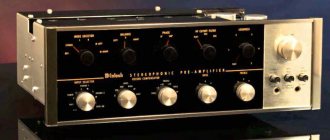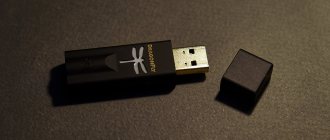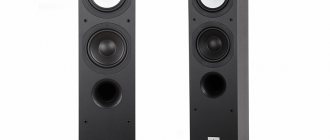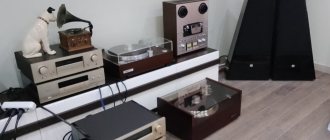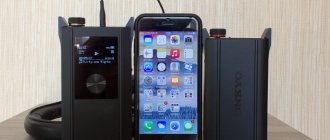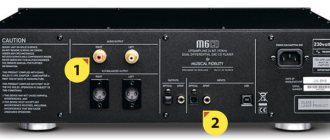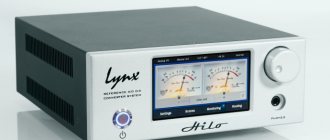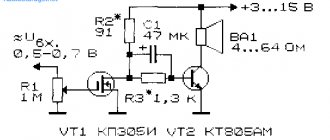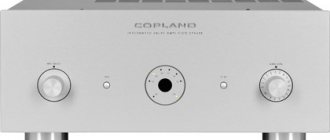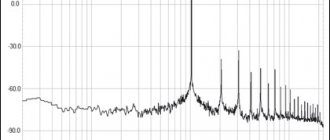Audioquest is primarily known as a manufacturer of cables for audio applications, both high-end and low-end. Their line of solutions for personal audio gained slightly less (though still more) popularity. If the NightHawk headphones passed me by (unfortunately), then I managed to get to know the updated version of the DragonFly DACs better.
What are “dragonflies” (this is how the name DragonFly is translated)? A very small, compact device the size of a typical flash drive (only a little heavier), with a USB connector on one side and a headphone output on the other. On the top panel there is a logo in the form of a dragonfly, which also acts as an indicator (using different shades it shows the resolution of the incoming signal), that’s all. Simplicity and minimalism. No controls (everything is controlled from the source), no additional features like optical output. The task of the device is very simple: turn on and listen to music.
It was AQ who were the first to popularize this format, later spawning many followers who surpassed their parent in sound quality, so it’s time to update the model, taking a qualitative step forward.
To do this, the company released two models at once, which received different colors as code names. DragonFly Black is a continuation of the line of “classic” models, this is evidenced by the index 1.5 it received (the previous dragonfly had version 1.2), instead of the Saber 9023, the 9010 and an analog volume control (controlled, however, from a computer) are now used. The maximum output voltage of the “black” DAC is 1.2 volts, the price tag is around $100. DragonFly Red, in turn, is an attempt to make a new device, of a higher level, relying less on previous developments. The red dragonfly uses Saber 9016, the volume control is digital, carried out by the DAC itself. Red is also pleased with the increased power, the output voltage is approximately 2.1 volts. Of course, the price has also increased, it is about $200. There is also a small difference in design, but more about that below.
Otherwise, the devices are similar, both support connection to iOS using an adapter from Apple and to Android, both are powered directly from the port, both have near-zero output impedance. Both models support resolutions up to 96 kHz/24 bit.
Packaging and delivery
The box as a whole is quite simple: flat, made of black cardboard with stylish printing. On one side there is a folding valve, the characteristics of the model are listed there. Since DragonFly is localized for the markets of the former USSR, the Russian language is also present there. The box contains a standard plastic tray in which the device itself and a leatherette case for it are fixed. The kit also includes various pieces of paper, in addition to instructions and a warranty, you will receive a promo code for the HDTracks store and a code for 60 days of free use of the very good, but very expensive Roon program.
Design and management
Despite the similar shape, DACs use different materials in their external design. The cheaper Black is made of plastic with a soft-touch effect; for Red they came up with a stylish coating reminiscent of either car enamel or pearlescent lipstick. However, they both look very good. It is noteworthy that these two DACs are a little more massive than their size seems, which gives away the use of metal in the construction. The build quality is very good, even in small details such as the tight fit of the caps covering the connectors.
The interface of both devices is as simple as possible, there’s not even anything special to describe here: we connect to the sound source, turn on the headphones, if necessary, select the DAC in the OS settings and enjoy. By the way, the instructions describe in detail the steps for connecting to almost all sources.
As additional options, Audioquest offers the Jitterbug USB power filtering device and small Dragontail extension adapters (available in versions for PC and Android). The latter, by the way, won’t hurt at all, since a DAC sticking out of a laptop’s USB port can become a source of damage if handled carelessly.
The funny thing is that, despite the higher output voltage, Red, according to measurements from Internet users, consumes slightly less voltage from the host, which allows it to use the host battery a little more economically during mobile use. Replacing the USB receiver from TI to Microchip allowed us to reduce consumption from 55-75 mAh (model 1.2) to ~25 mAh in new models.
DAC Audio: like DragonFly Black, only 9 times cheaper
Today we are reviewing something that you have been asking for so long. This is simply a gorgeous replacement for the built-in sound card, an analogue of the DragonFly Black DAC, which is practically unknown to the masses, but with a price tag that is 9 times less. That is, another option for cool sound for pennies.
Characteristics
- DAC: ESS ES9018K2M
- USB: SA9023A
- Amplifier: TPA6133A2
- Output power: 2 x 138 mW @ 16 ohms
- Audio resolution: up to 96 kHz/24 bit, DSD support not declared
- Frequency range: 20 Hz – 40 kHz
- Power: 5 volts 0.02 amps
- Inputs: USB
- Outputs: 3.5 mm jack
- Dimensions: 60 x 17 x 7 mm
- Weight: 6 g
- OS: Windows, MAC OS, Android, iOS
CHECK OUT THE CURRENT PRICE FOR DAC Audio
Video version of the review
Unpacking and packaging
The DAC arrived in a transparent plastic case. There was no equipment, although today such environmental friendliness is even welcomed. Well, the case itself can then be used for ear pads or any other small things.
Design/Ergonomics
The DAC body is made of metal. Externally and in size, it resembles a classic USB flash drive.
So what is it, a DAC or a sound card? This question comes up very often, so I will explain. The first differs from the second only in microphone support. Here, alas, it is not provided, which means it is a DAC. Moreover, the device does not react at all to removing the headphones. And this already tells us about the stationary type of use.
Although a full-fledged USB hints at this too strongly.
But you can also connect it to your mobile phone using the appropriate adapter. Of course it looks just creepy, but it works.
Moreover, it works fully, that is, with direct access players such as HiBy, Onkio, and all other applications without exception.
The device does not have its own power supply, but the device consumes very moderately: 5 volts 0.02 amperes. For a PC, this is of course not at all important, but when connecting to portable devices it can come in handy.
Among the shortcomings, I can note 2 obvious points: the cap, which is sure to be lost, and the constantly burning blue LED, which looks down when connected to a PC. Yes, this solves the problem of the annoying factor, but to whom does it shine? Cable? However, the device does not heat up during operation, and this is already positive.
To operate the DAC with a PC, you do not need to install any drivers; the system operates with quality up to 24-bit 96 kHz, that is, there is actually support for Hi-Res. I didn't find any ASIO drivers, although I may have looked poorly. Perhaps there is something from BRAVO, as for the older version of the USB chip.
From work, I note that it is connected to USB at one end, and at the other, connect headphones or the 3.5 mm plug of your favorite speakers.
In general, of course, speakers are not desirable, but nothing terrible will happen. At least not on acoustics with 3.5 mm. Jack
I constantly see in the comments that people are wondering about compatibility with certain smartphones. From my own experience, I will say that all USB DACs worked perfectly in all the smartphones I have from Samsung, Xiaomi, Lenovo and LG. I think all the others will work too, just look in your phone's Developer Settings and USB Settings settings.
Measurements
According to measurements, DAC Audio is as controversial a decision as the much more expensive DragonFly Black.
Well, except that the dragonfly looks a little better in terms of frequency response, and all possible distortions have fairly average indicators for the current day.
Unfortunately, I can’t compare it face to face; I’m basing it on the graphs of foreign bloggers.
Of course, you can study my measurements under light load in person. There's nothing terrible about them, but I wouldn't call them ideal either.
Iron
In terms of hardware, we have a decent DAC from ESS: ES9018K2M. However, this chip is far from uncommon in such devices. SA9023A is responsible for USB. Here the solution is already controversial; a fresher option could have been put in place. Then the issue with ASIO would be automatically resolved.
But the headphone amplifier is really good - TPA6133A2. Just imagine, 276 mW into a 16 ohm load. Not bad, really. Exactly the same amplifier is in the dragonfly. There is no background noise during pauses here. The amplifier is very loud, you can only listen to it at 30-50%, I have never raised the volume higher.
Sound
In the DAC Audio sound, the first thing that stands out is the full-bodied, juicy high frequencies. When directly compared with the CharmTek TPR22 (aka Dosmix), it is this range that makes the devices strikingly different. Moreover, I personally like the DAC Audio approach more than the roundness on the HF of CharmTek. This adds additional brightness, drive and gloss to the sound of strings and most wind instruments. And this is not to mention all sorts of cymbals, rattles and other percussion. However, there is a small nuance compared to TPR22 - the effect of pseudo masking of the middle. Where in Dosmix our attention is entirely focused on the center of the phonogram, on DAC Audio it shifts a little to its upper part. This is where taste preferences come from; some people like one thing, others another.
Regarding presentation, the device is natural and harmonious, without additional coloration of the mid frequencies or emphasis on the lows. The stage is constructed correctly, the instruments are lively, bright, with excellent separation and elaboration of timbres. The detailing here is also in order. You can take absolutely any headphones. I tried the fat and meat of pure dynamics, and the sound became thicker and more saturated. Dry and analytical hybrids also did not leave me indifferent. The body of the sound can be traced in this case as well, which noticeably makes the device stand out against the background of unnaturally thin whistles, for example, from FiiO.
Low frequencies have impressive depth and dynamics. Although the frequency response graph shows that this range has been slightly pressed at the very bottom, this can only be recognized by ear in very rare compositions and not on any acoustic system.
Mid frequencies, thanks to good lows and full highs, have good mass and unfold harmoniously in the spectrum. This is certainly not top-end sound, you shouldn’t imagine it, but it’s quite good. I think that the hero of the review will easily surpass the devices of the budget segment and with its capabilities will rest somewhere in the lower part of the average. And this is somewhere from 150 to 300 American presidents.
conclusions
Bottom line, DAC Audio has amazing sound for its 20 dollars. The whistle is no longer aimed at smartphones, although it can work with them. In terms of measurements, of course, it’s quite modest, but in terms of hardware, power and sound, the device shows its class and is not inferior to the more expensive DragonFly Black. For those who are looking for mobile sound for a PC or a replacement for the built-in sound card, I definitely recommend checking it out. Another really good option for inexpensive, but very high-quality sound.
CHECK OUT THE CURRENT PRICE FOR DAC Audio
Sound
To listen to the device, the following equipment was used - MacBook Pro Retina Late 2013 and iPhone 6 Plus as sources - Audirvana Plus as a player - Headphones ZMF Omni, Oppo PM-3, Titan 3 and Titan 5, Lear LHF-AE1d, Ambient Acoustics AM10, VE Monk and Asura v2, HiFiMan HE-400S, Dita Brass - Recordings in lossless format.
To begin with, I’ll make a small digression into the past and state that I didn’t like the sound of the previous DragonFly 1.2 model, even regardless of the price. Audioquest apparently decided to give its sound more lightness and focused on the high-frequency frequency, which broke the perception of the sound of this device into fragments. Fortunately, in the new modifications the manufacturer decided not to play these games anymore, and the sound of both new products is devoid of pronounced accents.
Let's go look at the sound of the models by seniority, starting, naturally, with the younger black one.
Overall, Black sounds almost neutral and quite good for its price. There are no obvious distortions, no excessive sharpness, resolution and micro-details are at a decent level for the price category. There is nothing special to describe here, since almost all points can be written “good”. The younger dragonfly doesn’t indulge in outstanding performance, but it doesn’t “graze its hinds” either. Among the shortcomings (not critical for the price) we can note some blurriness of the low frequencies and their tendency to slightly clog the mid-frequency range in melodies rich in “low-end”. This model also handles HF in a slightly boring way. They are, of course, not bad, but they clearly lack separation.
In the Red version of Audioquest they decided to go a different route and gave this model a completely different presentation, not similar to previous solutions. The red modification has a spectacular, involving sound with a slight hint of warmth. Compared to the black DAC, the Red sound is more massive, the notes are more weighty and thanks to this the whole melody sounds more realistic. The bass is better controlled and does not interfere with the midrange, despite the massiveness it is quite fast and textured (although not record-breaking). The mid frequencies show a pleasant cohesion, providing a good transfer of emotions and the integrity of the musical canvas. HF resolution is a little lacking, but for the price of this device this is not critical.
A few comparisons with other devices. I deliberately did not write comparisons with players, since the devices have different application scenarios and the choice will be made based on the usage scenarios.
DragonFly Black vs Encore mDSD Dragonfly is slightly better in resolution, but mDSD is better in overall perception, in terms of fidelity and overall musicality it is closer to the red version of the DAC, and also offers support for DSD and higher resolutions, although the practicality of this in a portable device is rather questionable. On the side of DragonFly is its smaller size and better power consumption.
DragonFly Black vs Fiio Q1 If we take the difference in form factors out of the equation and compare pure sound, then Fiio has a slower presentation with an emphasis on low frequencies, which on the one hand will please bass lovers, on the other hand, lovers of airiness will be disappointed. Resolution and micro-detail are better on the Audioquest, but the Fiio fares better with tight headphones (not surprising given the size of the Q1).
DragonFly Red vs Centrance DACPort HD and Slim In terms of sound, DACPort HD is noticeably better than DragonFly, it has naturalness, power and in general, it is half a step ahead in all respects, but at the same time DACPort HD is slightly larger and does not work with mobile devices. If we compare it with the Slim version, which costs comparable to Black, the difference in sound becomes slightly smaller (although still noticeable). Red will please fans of continuous feeding, and DACPort Slim is better at working out an imaginary scene, and will be a little ahead in speed.
AudioQuest DragonFly Red, Black and Cobalt DAC/amplifiers
I can’t even believe that such “audio flash drives”, which contain a digital-to-analog converter and a headphone booster, will soon be 10 years old. But the topic is still relevant, which motivates AudioQuest to release new DragonFly models. So we have a reason to review the entire color palette of devices marked with a dragonfly figurine.
It’s unlikely that anyone could have imagined that the idea of combining a USB-DAC with a high-quality telephone amplifier in one case would be most elegantly implemented not by some company that produces headphones or electronic components, but by one of the most famous American manufacturers of audio cables.
Back then everyone was running around with a similar idea. Some made these devices in the traditions of the “hi-fi” school - in the form of a stationary DAC/amplifier, giving the component an input selector and different outputs, a volume control, various modes, a display, etc. The more enterprising ones tried to do the same thing, but in a compact format for mobile use and with autonomous power supply. And the most progressive ones even abandoned the battery section - by that time, DACs and low-power amplifier chips had appeared, for which the currents from the standard five-volt USB bus were enough to operate.
And if now you set yourself the goal of finding the most affordable and high-quality microDAC with good parameters, then there will be few alternatives to DragonFly.
But AudioQuest generally decided to cut off everything that could be done without, and made their DAC/amplifier in the format of a flash drive, but in the likeness of an adapter: the signal came in from the USB side, and came out from the jack socket. All! And to make it clear what type of signal passes along the path, we made the branded dragonfly icon functional - changing color depending on the bit depth of the converted audio data. Isn't it brilliant?
AudioQuest certainly didn't disrupt the head-fi market with its Dragonflies, but it did make it possible to play high-quality music through audiophile headphones from laptops, computers or smartphones without any expensive or bulky intermediate components.
Naturally, the initiative was picked up by other companies, but AudioQuest responded to this with a pricing policy that actually swept away its competitors. And if now you set yourself the goal of finding the most affordable and high-quality microDAC with good parameters, then there will be few alternatives to DragonFly. The only significantly cheaper ones are some “tail” DACs from Aliexpress, made in the form of cable adapters for connecting headphones to smartphones. But this is a product from a different category.
The original DragonFly are universal things: they are connected directly to a computer or laptop, to tablets or smartphones - through adapters that are widely available. By the way, there are also branded ones - in the AudioQuest assortment these adapters are placed in the DragonTail Extender section. The company also suggests using a separate JitterBug filter adapter to clear data from interference.
A little about evolution
Perhaps the main advantage of the entire DragonFly family is that the manufacturer does not cease to develop these devices both at the software level, constantly improving the functionality of updated firmware, and at the hardware level.
For example, prototypes were made on converters from Wolfson that were widespread at that time and suitable in all respects, but according to the head of AudioQuest William E. Lowe, the required quality could not be achieved, so a more expensive chip from ESS was chosen as the basis.
The first production model, to the development of which the company attracted Gordon Rankin, an experienced engineer from Wavelength Audio, already used a Texas Instruments TAS1020 USB controller at the input, supporting Steamlength - a special asynchronous USB protocol with reclocking to reduce jitter. The output part is a specialized amplifier chip from Burr Brown.
But less than two years have passed since AudioQuest is making the second generation of DragonFly, in which the “harness” is completely changed.
But less than two years have passed since AudioQuest is making the second generation DragonFly V.1.2, in which the “harness” is completely changed. This modification sounded just as good as the first, but was cheaper (if you look at the American price in dollars).
The DragonFly Black reviewed here, which is so similar to the first version (only gold plating on the USB plug was added), began production in 2016. But in fact, this is another radical redesign up to version V.1.5: the converter is again from ESS (but already a 32-bit Saber ES9010), but the USB input is served by an economical PIC32MX270 from Microchip, and the output is a new high-performance amplifier based on the TPA6130 chip from TI . The advantage of this model is not only lower power consumption (which allows it to be used with smartphones), but also support for MQA decoding.
In parallel with the Black, the company also released the DragonFly Red model, which could be used with stationary equipment - the signal level at the telephone output was raised from 1.2 V to the standard 2.1 V for linear connections. At the same time, the red model received not only a more advanced output amplifier, but also a higher class DAC (ES 9016) and a digital 64-bit attenuator that does not coarse the signal.
The most recent result of the dragonfly selection is the Cobalt model. It also features a higher voltage amplifier. Compared to Black and Red, the shape of the case and the color indication of the passing digital stream have changed (88.2 and 96 kHz are displayed not in orange and purple, but in yellow and light blue). But there are also fundamental differences. At the input is the most advanced USB controller PIC32MX274 (consumes less current, but is 33% faster). The main component has also been replaced - the top-end ES9038Q2M is now the converter. The third innovation is the appearance in the kit of a proprietary DragonTail adapter from USB-C (male) to USB Type-A (female). This generosity is obviously due to the fact that Apple has finally abandoned the usual rectangular USB ports in all its laptops. But this is a nice bonus for owners of smartphones with a USB-C terminal.
All DragonFly models work with Hi-Res Audio up to 24-bit/96 kHz (higher streams are downsampled). In the box for each DAC you will find promotional codes for connecting to popular streaming networks that deliver high-definition content, so you can more fully experience all the benefits in sound quality.
Is there a big difference in hearing?
The Internet is full of reviews and user reviews of DragonFly, most of which give positive ratings to all three models. But the “degree of delight” varies greatly depending on the equipment and software players that served as the source for tests and comparisons. That's why I started my little research from this side.
Almost all computers, tablets and smartphones have three parts where the original signal can be damaged: the built-in system audio mixer, the DAC itself and the telephone amplifier. In fact, there are more critical points, but these are the most harmful. The mixer can coarse the bit depth of the stream to several bits, the converter built into the audio card will certainly be significantly inferior in parameters to any normal one, and the headphone output can be serviced by a cheap microcircuit.
We get a piece of candy: a powerful, comfortable, moderately developed and completely non-tiring sound!
In all cases, when on the source side everything is bad with the last two links, any DragonFly will give a colossal increase in quality - you just need to make sure that in the player settings the stream is output to the USB DAC without resampling and any software-imposed effects. And then this was completely confirmed.
Let's take some inexpensive Android smartphone of an older generation, which never sounded good from its phone output even with the best software player, connect the most affordable DragonFly Black to it and get a piece of candy: powerful, comfortable, moderately sophisticated and not at all tiring sound! By the way, I would not say that the “dragonfly” somehow heavily loads the smartphone’s battery - if it has a battery with a capacity of 4000 - 5000 mAh, then the discharge process, according to my observations, is definitely not accelerated by several times, but only by some percentage (compared to the same continuous listening without DragonFly).
When the source is an almost flagship-level smartphone, made on modern chipsets and with Android version no lower than 10, the difference between the standard and Dragonfly output becomes less noticeable - even with the advanced Red model, which differs from Black in a more dynamic and polished style.
The pair with Vivo X50 Pro deserves special consideration. In this smartphone, the standard audio path is complemented by a built-in DAC/amplifier from Asahi Kasei. And here he is the only one that produced a neutral, lively and rich sound even without the help of DragonFly. Only the older Cobalt was able to “outplay” it, and only in those programs where there was no powerful, complex bass (even with this DAC model it turned out to be a little flabby). But here I blame not AudioQuest, but the source itself. It is possible that the DAC from the Vivo smartphone simply did not receive enough power.
And this assumption was confirmed by the MacBook Air, with which Cobalt revealed the structure and dynamics of the bass much better. For such a source, I can also recommend Red. But Black for Apple sources no longer looks so good. As in combination with highly sensitive headphones, it is alarming due to the increased noise level and insufficiently clean high frequencies, even in comparison with the standard telephone output.
With iPhones, everything is generally simple - you will get a noticeable increase in the clarity and information content of playback only by using some paid audiophile application that will allow you to output sound to a DAC in Hi-Res. The hardware of these devices seems to be so good that there is no point in connecting anything below the DragonFly Cobalt.
Please note that throughout I spoke specifically about quality, and not about quantitative indicators. All DragonFlys, including Black, have such a large output power reserve that they easily work with high-impedance headphones that are not intended for portable use. So if in your smartphone-headphone combination the issue of insufficient volume comes first, then any “dragonfly” will easily solve this problem.
Purely concrete
In conclusion, a quick run of all DragonFly on one source (MacBook Air) with different headphone models.
Such standard “plugs” as the Focal Spark are simply transformed with any “dragonfly” - the boominess in the bass goes away, the slightly weak dynamics in the treble are boosted, and a lot of air appears. Surprisingly, the simplest headphones suddenly start to sound like expensive, cool IEMs.
The second “standard” in the form of overhead and conditionally closed Audio-Technica ATH-MSR7B pleased us with essentially the same thing: a clear texture appeared in the bass, and the high frequencies began to sound more natural. Red also reduced the dryness in the highs, and Cobalt also removed some of the tint in the mids.
Amazingly, all the “dragonflies” cope well with low-sensitive magnetic planars. Dynamics - more than!
Audiophile closed Denon AH-D9200 opened normally only with Cobalt. With other “dragonflies,” progress was not so much in quality as in the assertiveness of the sound, but with the older DAC model, the smallest nuances in the recordings themselves and subtle technical differences in formats began to be heard. The space in MQA tracks, for example, seemed much more detailed compared to the same recordings of regular CD quality.
The combination with the extremely sensitive Campfire Audio Andromeda armature IEMs is also capricious. The version with Black gives the most powerful bass density and brain-piercing dynamics - it’s simply dangerous for hearing. And reducing the volume to minimum values reveals another problem - noticeable noise. With Red you get the same power delivery, but it is more flexible, the images are more physical, and the noise is less noticeable. A more or less balanced sound is obtained only with Cobalt. The background noise is almost unnoticeable and the detailing is kind of crazy, there’s a lot of air...
Let's look at the other extreme - take the “heavy” 110-ohm Audeze LCD-3. Amazingly, all the “dragonflies” cope well with low-sensitive magnetic planars. Dynamics - more than! But the microdynamic picture is not so rich. Even Cobalt can't cram into these headphones all the details that cool music sources and stationary headphone amplifiers easily provide.
The latest sample is Meze Empyrian. Also magnetic planars, but hybrid, with an orthodynamic section, and a little “lighter” than the American ones. In principle, even some smartphones are already “pulling” them somehow. But with DragonFly Cobalt, these headphones sounded as if they were given a signal from a very serious system - tactfully, collectedly, surprising not so much with super detail, but with the natural purity and organic nature of all reproduced sounds. Super!
This result again makes us think about how to properly distribute spending on the system. We always advise choosing components that are equivalent to each other, but here another formula gave an excellent sum: very expensive headphones + a standard laptop from Apple. True, all this works smoothly only thanks to a small “gasket” from AudioQuest.
In short, you don’t mind spending money on Cobalt without even listening. Well, we recommend approaching cheaper DragonFly models simply with your own source and headphones. And then you won’t be mistaken in your choice.
COMPONENTS
- Sources laptop Apple MacBook Air A1465
- smartphone Xiaomi Redmi Note 8T, Samsung A50, Vivo X50 Pro, iPhone 11
- Focal Spark
share
Tags: AudioquestAudioQuest DragonFly BlackAudioQuest DragonFly CobaltAudioQuest DragonFly RedExpert's Choice
Compatibility
In general, compatibility with headphones here follows primarily from the output power, Black is aimed primarily at IEMs and sensitive full-size ones, Red can easily drive headphones of average sensitivity, including high-ohm ones (within reasonable limits, of course). The near-zero output impedance of the models makes them almost universal, so you can choose headphones solely based on taste preferences.
The models are very universal in terms of genre, although the black DAC copes worse with complex styles such as classical and metal. Sensitivity to recording quality for both models is slightly above average, about 6 points out of 10.
